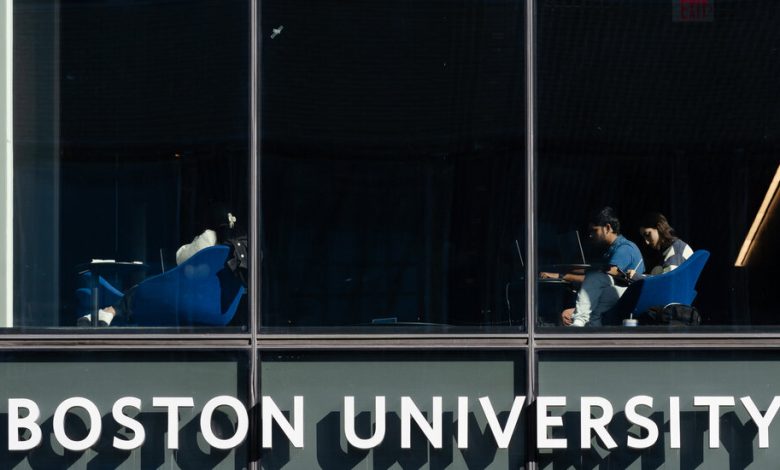The Newest Union Members Are Undergrads

Sam Betsko figured out fast that being a resident assistant in a college dorm would demand more than helping locked-out students and pleading with sophomores to, for the love of God, turn down the music.
In her role at Boston University, there were days of compulsory, unpaid training, and the specter of arbitrary discipline from bosses. She had to prepare to respond to emergencies like a student’s anxiety attack or sexual assault. Then she learned that some resident assistants had been assigned to work far more than others — without extra compensation — in a gig that offered no more than housing, a meal plan, tickets to school events and a weekly stipend that could barely buy a drink.
The resident assistants, she thought in 2021, needed a union. This past March, they voted overwhelmingly to have one. Contract negotiations began Friday, capping a week when residence life workers at Swarthmore College and Smith College voted to unionize.
Resident assistants, known as R.A.s, are on the march, part of a wave of unionization by undergraduates who work in places like dining halls and libraries, and attend schools like Harvard, the University of Oregon and Western Washington University. This year alone, around 20,000 undergraduates, many of them at California State University, the largest four-year public university system in the country, have cast ballots in union elections or secured the opportunity to vote.
“It’s really not hard to see that, up until this point, universities have had all of the leverage,” said Ms. Betsko, now a senior, who is majoring in English. “We see that students have been exploited by this.”
The students who have joined the labor movement account for a fraction of the country’s 15 million or so undergraduates. But the movement is nevertheless a glimpse at how campus culture is shifting. As families increasingly question whether a college education is worthwhile, undergraduate workers like R.A.s are often asking the same question about their campus jobs. And the R.A.s, who have often been compensated with benefits like free housing, are now seeking wages and workplace protections that were scarce a decade ago.
“We have spent most of our lives navigating systems that were not built for us and not built in our favor,” said Nathan Duong, a junior at Boston University. “So you take that, and then you put that in context of just a broader uptick in labor organizing across the country, and I think it makes a lot of sense.”
Many university leaders believe they already provide sufficiently generous benefits to student workers, such as housing that can be worth $15,000 or more a year. And some have sometimes waged aggressive legal efforts to try to derail unionization.
But they are confronting a generation of students far more receptive to organized labor than young people in even the recent past. A Gallup poll found that 60 percent of people between the ages of 18 and 34 approved of unions in 2013; this year, that figure was 78 percent, the highest in more than two decades of polling.
And students, having watched organizing campaigns unfold at cultural cornerstones like Amazon and Starbucks, have found themselves wondering whether they could benefit from the labor groundswell, too.
“For most people, it was not a tough sell,” said David Whittingham, a senior who helped build a new union for R.A.s at Tufts University, just outside Boston. “The struggle, I think, has been less of convincing and more of turning people out.”
With help from groups like the Service Employees International Union and the Office and Professional Employees International Union, students consolidated support for elections, contract talks and headline-making protests. Their muscle has surprised longtime observers of the labor movement, some of whom have wondered where, exactly, young adults learned some of the finer points of the National Labor Relations Act of 1935. (Part of the answer: Instagram direct messages with organizers on other campuses.)

Many university officials believe they already provide sufficient benefits to student workers, such as housing.
“These students have clearly studied this and have utilized those procedures in a very sophisticated way,” said William A. Herbert, the executive director of Hunter College’s National Center for the Study of Collective Bargaining in Higher Education and the Professions.
A central challenge for the students has been reframing decades of institutional preaching about the purpose of student work. “It was a fundamental divide,” said Anisha Uppal-Sullivan, a Tufts junior. “We saw ourselves as workers where the university saw us in more of a student leadership capacity.”
A Tufts spokesman said administrators were not available for interviews, but other universities have questioned whether unions were necessary for resident assistants.
The University of Pennsylvania, where R.A.s voted in September to unionize, told the federal government that collective bargaining was “incompatible with the unique nature” of the job, which it depicted as an opportunity “to learn how to be effective student leaders in an educational environment.”
At Tufts, R.A.s said that some school negotiators appeared not to understand their jobs and played down their contributions.
R.A.s there and at other schools recounted how they had helped crime victims go to the police, enforced coronavirus protocols and contended with mental health crises. Their work, they said, did not fit neatly into a shift.
“Kids are forfeiting their sleep, kids are forfeiting their studying,” Ms. Uppal-Sullivan said of resident assistants. “That’s something that should be compensated.”
At Tufts, R.A.s struck on one of the busiest days on campus: student move-in day. The university, which had given them housing, soon reached a deal that promised a stipend of $2,850 per academic year, up from nothing.
That money can be crucial, R.A.s said, because universities sometimes limit, explicitly or implicitly, their ability to hold second jobs. And many R.A.s said they are struggling to get by.
“I have a kitchen and I love that, but that’s not what I need,” said Jasmine A. Richardson, a junior at Boston University. “I need food.”
Ms. Richardson understands why people are often stunned to hear of the unionization effort, partly because she herself had not initially grasped the scope of the role and was not fully prepared for it. A restaurant prepared its workers better, she suggested, than Boston University prepared its R.A.s.
“If training here makes me feel like my training at Red Lobster was the best thing that I could have ever done, there’s a problem — nothing against Red Lobster,” she said.
Colin Riley, a spokesman for Boston University, declined to comment about the union beyond writing in an email this fall that the university anticipated “beginning bargaining in good faith for a fair contract with them soon.” He did not respond to an inquiry about the accounts of some of the university’s R.As.
Students won the national right to organize only in 2016, during Barack Obama’s presidency, when the National Labor Relations Board concluded that undergraduate workers could be classified as employees with unionization rights. (The federal law does not cover public institutions, which are governed by state statutes and rules. R.A.s at the University of Massachusetts Amherst, for example, unionized in 2002, but their effort did not spark much of a broader movement.)
According to Mr. Herbert’s data, at least 41 new bargaining units involving students, graduate or undergraduate, have formed since the start of 2022. In the preceding nine years, Mr. Herbert’s center reported, there were a total of 21 new units.
Union officials know they may have limited time to organize on more campuses since a future labor board could reverse the 2016 ruling, particularly if a Republican wins the presidency next year. But Mark Gaston Pearce, the executive director of the Workers’ Rights Institute at Georgetown University Law Center, predicted that even then, few schools would rush to rid themselves of new unions.
“Irrespective of one’s philosophy on the question, universities are interested in achieving stability,” said Mr. Pearce, who was the labor board’s chairman and in the majority for the 2016 decision.
One of the greatest challenges for the new unions is the constant flux in membership, as students graduate, drop out and change jobs. At Tufts, R.A.s are trying to figure out what their union should look like day to day, knowing that the next bargaining battle will come after many current students have left.
And at Boston University, students like Ms. Betsko know they will have only so much time to enjoy the benefits of any deal. She was philosophical about the time crunch.
“It’s not just for us,” she said of their potential contract. “It would be for every res life worker who comes after us. There’s no point in being selfish.”




